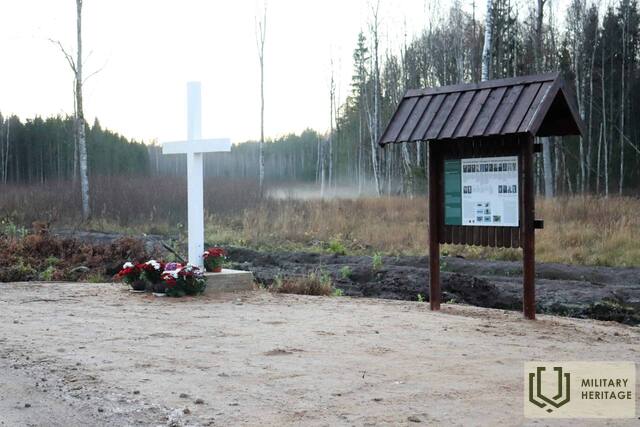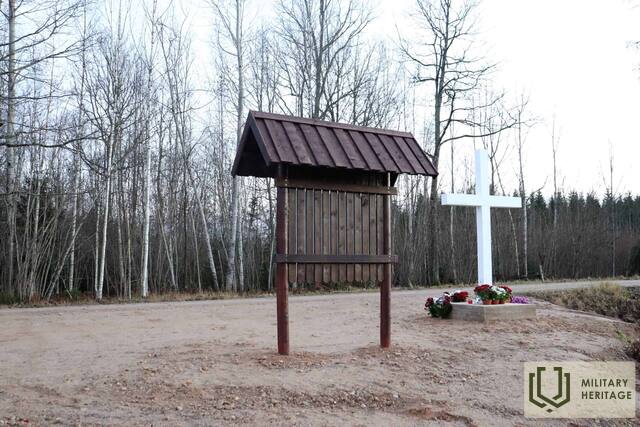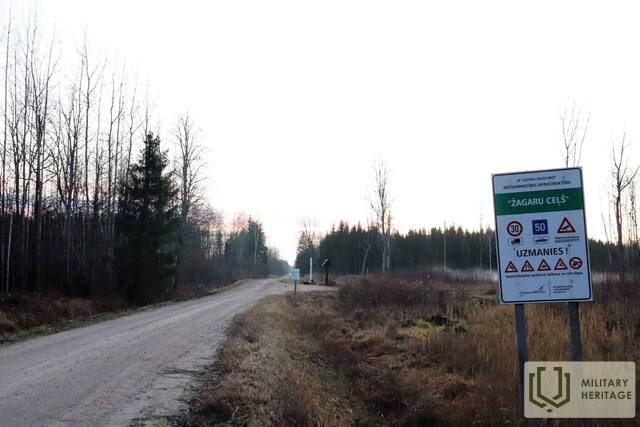Memorial site at the site of the national partisan battle of February 13, 1945 in the Diamond Forest of Kalna Parish
Memorial site



 168
168



The memorial site was created on the regional road P74 Siliņi - Aknīste, 12 kilometers from Aknīste, turning onto the Latvian State Forest "Žagari ceļa".
The vast forest massif of the northern part of Elkšķi parish already at the end of the summer of 1944 became a gathering place for people who were preparing for armed struggle against the Soviet occupation power. At the end of 1944, national partisan groups began to form in the Aknīste area. A suitable place for establishing a partisan camp was the Diamond Forest , which was located on the southern edge of the Elkšķi large forest, near the Aknīste Great Swamp. There, less than 10 kilometers from Aknīste parish, the national partisans created three winter bunkers for wintering. Communications of the men gathered in the forest were ensured with the support of nearby houses - Baltimores, Gargrodes, Līči, Priedes, Krūmi and residents of other houses, neighbors and partisans.
The partisan battle with the soldiers of the Latvian SSR Ministry of State Security in the Diamond Forest took place on February 13, 1945. The Chekists, having taken hostages, drove them forward to reveal the partisan bunkers. The Forest Brothers, seeing the danger, opened fire, not sparing the hostages. 10 representatives of the Soviet occupation troops, eight national partisans and four hostages fell in the battle. Despite the losses of the Forest Brothers, the Chekists failed to capture the partisan bunkers. The surviving partisans waited for darkness and left the settlement. The Chekist soldiers wounded in the battle, groaning, were unable to leave the battlefield. After this battle, which can be considered the forest brothers' first "baptism of battle", the partisans felt like brothers and the rifle seemed more precious than anything, like the only reliable savior.
The White Cross and information stand in the Diamond Forest were installed on Lāčplēsis Day - November 11, 2022. The creation of the memorial site was supported by the Jēkabpils regional government, the association "Tēvzemes sargi" and the Latvian State Forests. The author of the content of the information stand is historian Haralds Bruņinieks.
Used sources and references:
H. Bruņinieks. Cheating Death. Riga: Latvian Media, 2022, pp. 213-221.
https://www.jekabpilslaiks.lv/lv/zinas/kalna-pagasta-atklaj-mezabraliem-veltitu-pieminas-vietu/
https://selija.com/apskati/kultura-un-vesture/dimantu-meza-kaujas-pieminas-vieta/
Related timeline
Related stories
Selija's forest brother settlement in the Sūpe swamp
The Sūpes swamp is associated with the sites of national partisan settlements and battles, which were formed through the interaction of people and places. It is described in the ballad of the exiled Latvian writer Alberts Eglītis about the events in his native Sūpes swamp “In Moss and Mud” - a tribute to the Sūpes swamp partisans:
… “In 1945, as autumn glowed in the swamp -
On Pokļevinskis' birthday, Lieljānis shares at dinner:
Beer fermented in willows,
The Romulans worship butter,
I dry my mother's caraway bread,
Dried ham in March cuts,
And Stuchka's onions,
Ildzeniece cheese.
Rooms in resinous walls
And lightning has struck hearts,
And in eleven souls languish-
"The roots that have rotted in the ground..."
This interpretation of the past, with its post-World War II events, included human testimonies, expressions of spirit, and value systems. It recalls the popular support for the national partisans, whom the occupying power could not defeat so easily.






